Financial Accounting Report: Performance Analysis and Comparison
VerifiedAdded on 2022/12/29
|15
|2530
|1
Report
AI Summary
This report presents a comprehensive analysis of financial accounting principles applied to a sole proprietorship, specifically Linda's business. The report begins with the foundational steps of financial accounting, including the creation of journal entries and their subsequent posting to the ledger. It then proceeds to the extraction of a trial balance, followed by the preparation of an income statement and balance sheet to assess the financial position of the business. The report further delves into Part-B, which involves a detailed calculation of various financial ratios, such as net profit margin, gross profit margin, current ratio, and acid test ratio. These ratios are then used to analyze Linda's business performance and compare it with that of its competitors, providing insights into the business's strengths and weaknesses. The report concludes with a summary of findings and references to the sources used.
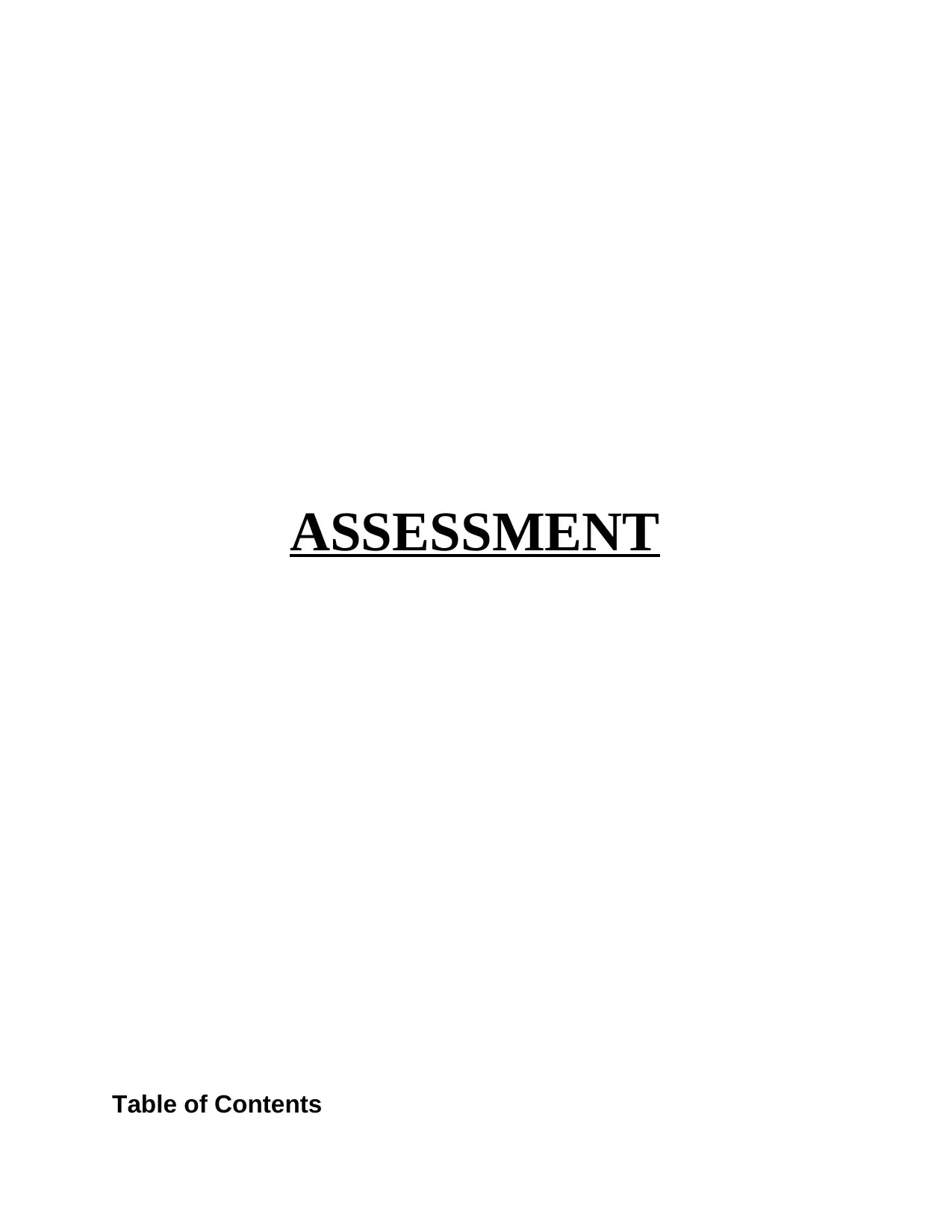
ASSESSMENT
Table of Contents
Table of Contents
Paraphrase This Document
Need a fresh take? Get an instant paraphrase of this document with our AI Paraphraser
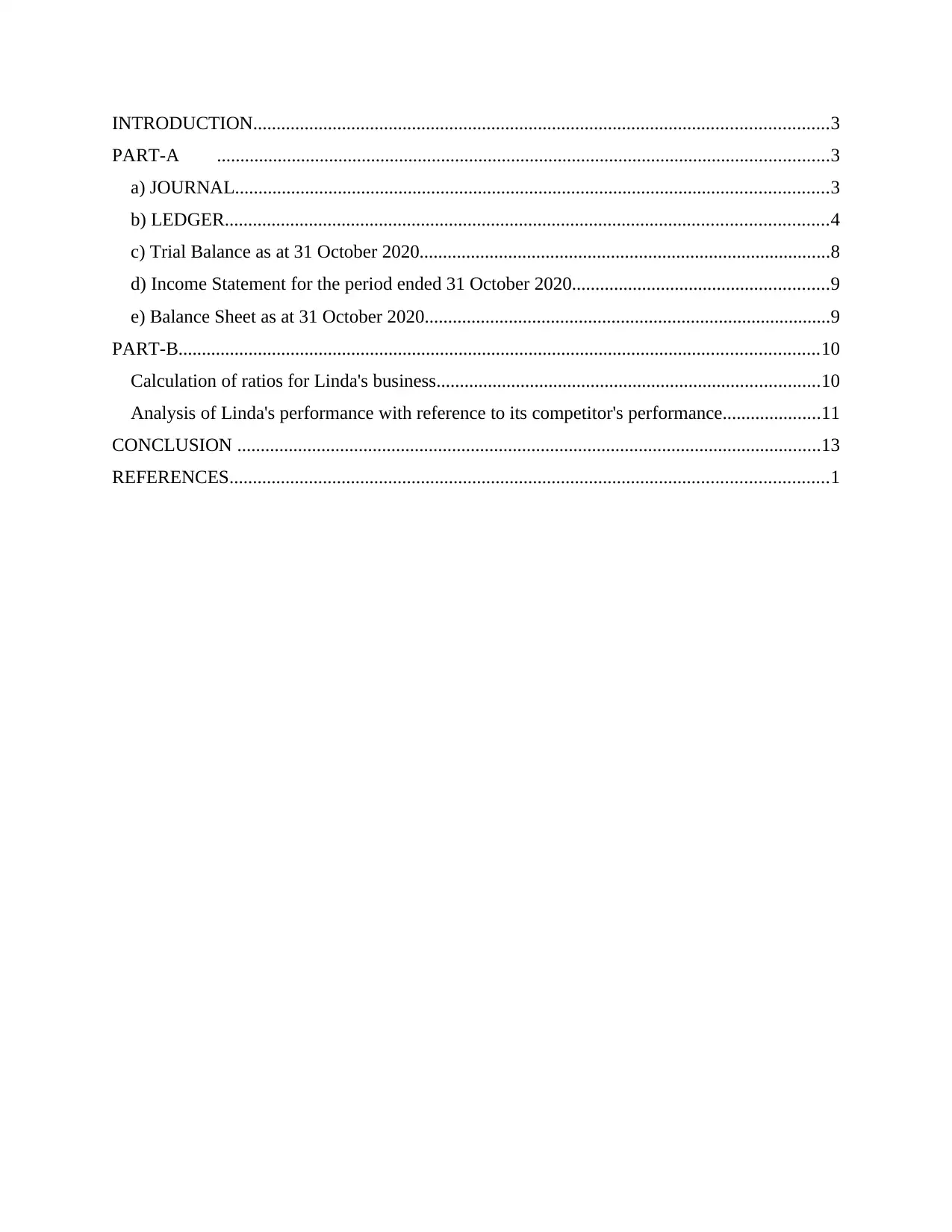
INTRODUCTION...........................................................................................................................3
PART-A ...................................................................................................................................3
a) JOURNAL...............................................................................................................................3
b) LEDGER.................................................................................................................................4
c) Trial Balance as at 31 October 2020........................................................................................8
d) Income Statement for the period ended 31 October 2020.......................................................9
e) Balance Sheet as at 31 October 2020.......................................................................................9
PART-B.........................................................................................................................................10
Calculation of ratios for Linda's business..................................................................................10
Analysis of Linda's performance with reference to its competitor's performance.....................11
CONCLUSION .............................................................................................................................13
REFERENCES................................................................................................................................1
PART-A ...................................................................................................................................3
a) JOURNAL...............................................................................................................................3
b) LEDGER.................................................................................................................................4
c) Trial Balance as at 31 October 2020........................................................................................8
d) Income Statement for the period ended 31 October 2020.......................................................9
e) Balance Sheet as at 31 October 2020.......................................................................................9
PART-B.........................................................................................................................................10
Calculation of ratios for Linda's business..................................................................................10
Analysis of Linda's performance with reference to its competitor's performance.....................11
CONCLUSION .............................................................................................................................13
REFERENCES................................................................................................................................1
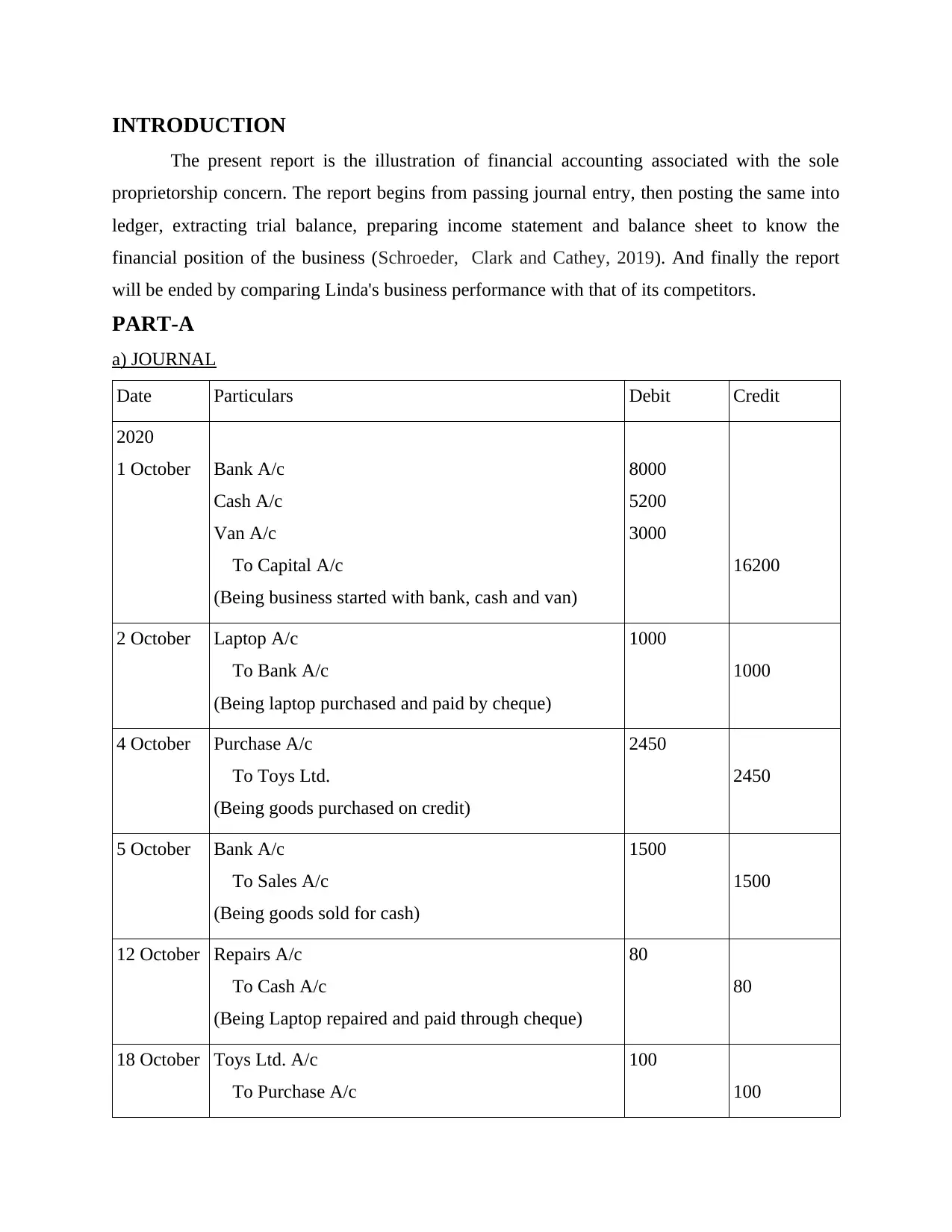
INTRODUCTION
The present report is the illustration of financial accounting associated with the sole
proprietorship concern. The report begins from passing journal entry, then posting the same into
ledger, extracting trial balance, preparing income statement and balance sheet to know the
financial position of the business (Schroeder, Clark and Cathey, 2019). And finally the report
will be ended by comparing Linda's business performance with that of its competitors.
PART-A
a) JOURNAL
Date Particulars Debit Credit
2020
1 October Bank A/c
Cash A/c
Van A/c
To Capital A/c
(Being business started with bank, cash and van)
8000
5200
3000
16200
2 October Laptop A/c
To Bank A/c
(Being laptop purchased and paid by cheque)
1000
1000
4 October Purchase A/c
To Toys Ltd.
(Being goods purchased on credit)
2450
2450
5 October Bank A/c
To Sales A/c
(Being goods sold for cash)
1500
1500
12 October Repairs A/c
To Cash A/c
(Being Laptop repaired and paid through cheque)
80
80
18 October Toys Ltd. A/c
To Purchase A/c
100
100
The present report is the illustration of financial accounting associated with the sole
proprietorship concern. The report begins from passing journal entry, then posting the same into
ledger, extracting trial balance, preparing income statement and balance sheet to know the
financial position of the business (Schroeder, Clark and Cathey, 2019). And finally the report
will be ended by comparing Linda's business performance with that of its competitors.
PART-A
a) JOURNAL
Date Particulars Debit Credit
2020
1 October Bank A/c
Cash A/c
Van A/c
To Capital A/c
(Being business started with bank, cash and van)
8000
5200
3000
16200
2 October Laptop A/c
To Bank A/c
(Being laptop purchased and paid by cheque)
1000
1000
4 October Purchase A/c
To Toys Ltd.
(Being goods purchased on credit)
2450
2450
5 October Bank A/c
To Sales A/c
(Being goods sold for cash)
1500
1500
12 October Repairs A/c
To Cash A/c
(Being Laptop repaired and paid through cheque)
80
80
18 October Toys Ltd. A/c
To Purchase A/c
100
100
⊘ This is a preview!⊘
Do you want full access?
Subscribe today to unlock all pages.

Trusted by 1+ million students worldwide
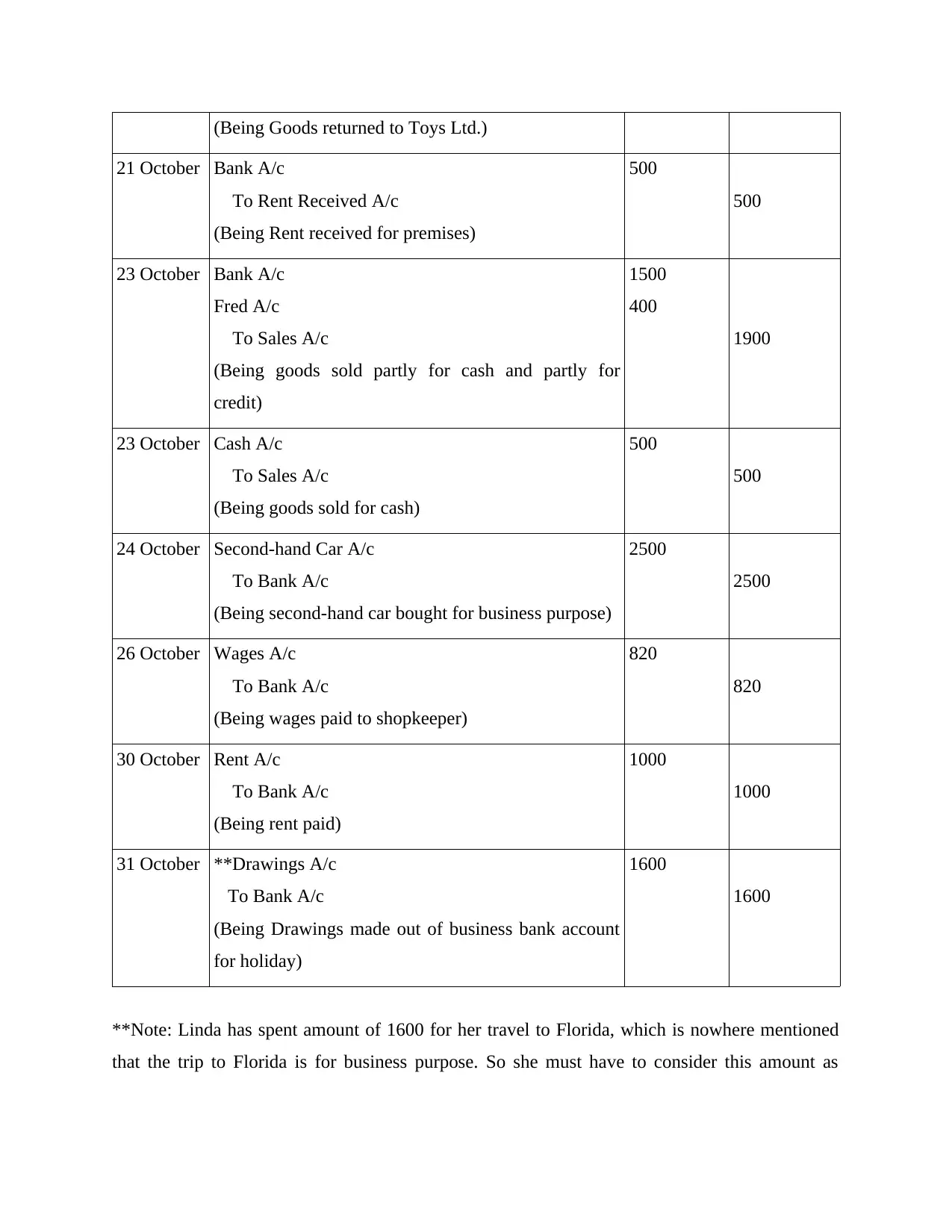
(Being Goods returned to Toys Ltd.)
21 October Bank A/c
To Rent Received A/c
(Being Rent received for premises)
500
500
23 October Bank A/c
Fred A/c
To Sales A/c
(Being goods sold partly for cash and partly for
credit)
1500
400
1900
23 October Cash A/c
To Sales A/c
(Being goods sold for cash)
500
500
24 October Second-hand Car A/c
To Bank A/c
(Being second-hand car bought for business purpose)
2500
2500
26 October Wages A/c
To Bank A/c
(Being wages paid to shopkeeper)
820
820
30 October Rent A/c
To Bank A/c
(Being rent paid)
1000
1000
31 October **Drawings A/c
To Bank A/c
(Being Drawings made out of business bank account
for holiday)
1600
1600
**Note: Linda has spent amount of 1600 for her travel to Florida, which is nowhere mentioned
that the trip to Florida is for business purpose. So she must have to consider this amount as
21 October Bank A/c
To Rent Received A/c
(Being Rent received for premises)
500
500
23 October Bank A/c
Fred A/c
To Sales A/c
(Being goods sold partly for cash and partly for
credit)
1500
400
1900
23 October Cash A/c
To Sales A/c
(Being goods sold for cash)
500
500
24 October Second-hand Car A/c
To Bank A/c
(Being second-hand car bought for business purpose)
2500
2500
26 October Wages A/c
To Bank A/c
(Being wages paid to shopkeeper)
820
820
30 October Rent A/c
To Bank A/c
(Being rent paid)
1000
1000
31 October **Drawings A/c
To Bank A/c
(Being Drawings made out of business bank account
for holiday)
1600
1600
**Note: Linda has spent amount of 1600 for her travel to Florida, which is nowhere mentioned
that the trip to Florida is for business purpose. So she must have to consider this amount as
Paraphrase This Document
Need a fresh take? Get an instant paraphrase of this document with our AI Paraphraser
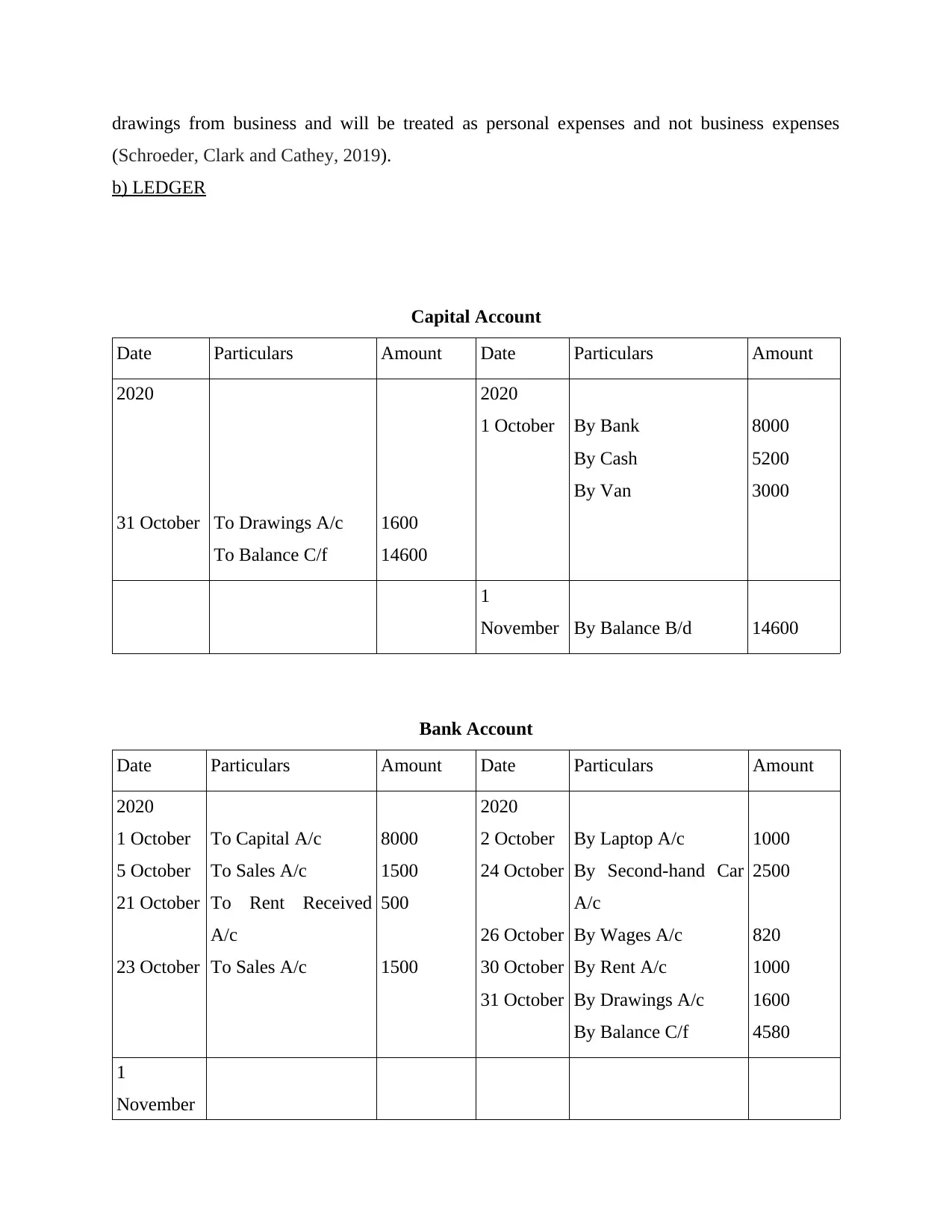
drawings from business and will be treated as personal expenses and not business expenses
(Schroeder, Clark and Cathey, 2019).
b) LEDGER
Capital Account
Date Particulars Amount Date Particulars Amount
2020
31 October To Drawings A/c
To Balance C/f
1600
14600
2020
1 October By Bank
By Cash
By Van
8000
5200
3000
1
November By Balance B/d 14600
Bank Account
Date Particulars Amount Date Particulars Amount
2020
1 October
5 October
21 October
23 October
To Capital A/c
To Sales A/c
To Rent Received
A/c
To Sales A/c
8000
1500
500
1500
2020
2 October
24 October
26 October
30 October
31 October
By Laptop A/c
By Second-hand Car
A/c
By Wages A/c
By Rent A/c
By Drawings A/c
By Balance C/f
1000
2500
820
1000
1600
4580
1
November
(Schroeder, Clark and Cathey, 2019).
b) LEDGER
Capital Account
Date Particulars Amount Date Particulars Amount
2020
31 October To Drawings A/c
To Balance C/f
1600
14600
2020
1 October By Bank
By Cash
By Van
8000
5200
3000
1
November By Balance B/d 14600
Bank Account
Date Particulars Amount Date Particulars Amount
2020
1 October
5 October
21 October
23 October
To Capital A/c
To Sales A/c
To Rent Received
A/c
To Sales A/c
8000
1500
500
1500
2020
2 October
24 October
26 October
30 October
31 October
By Laptop A/c
By Second-hand Car
A/c
By Wages A/c
By Rent A/c
By Drawings A/c
By Balance C/f
1000
2500
820
1000
1600
4580
1
November
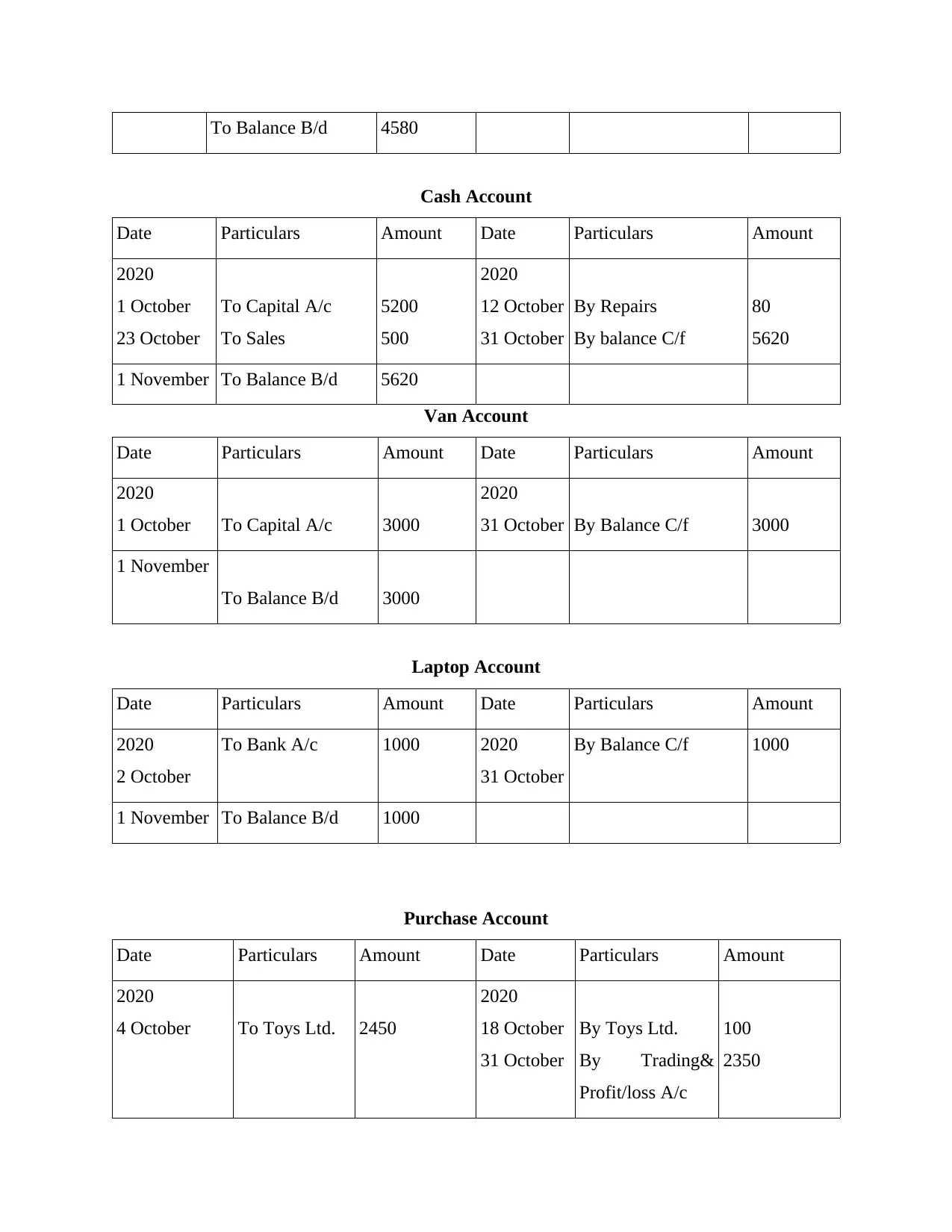
To Balance B/d 4580
Cash Account
Date Particulars Amount Date Particulars Amount
2020
1 October
23 October
To Capital A/c
To Sales
5200
500
2020
12 October
31 October
By Repairs
By balance C/f
80
5620
1 November To Balance B/d 5620
Van Account
Date Particulars Amount Date Particulars Amount
2020
1 October To Capital A/c 3000
2020
31 October By Balance C/f 3000
1 November
To Balance B/d 3000
Laptop Account
Date Particulars Amount Date Particulars Amount
2020
2 October
To Bank A/c 1000 2020
31 October
By Balance C/f 1000
1 November To Balance B/d 1000
Purchase Account
Date Particulars Amount Date Particulars Amount
2020
4 October To Toys Ltd. 2450
2020
18 October
31 October
By Toys Ltd.
By Trading&
Profit/loss A/c
100
2350
Cash Account
Date Particulars Amount Date Particulars Amount
2020
1 October
23 October
To Capital A/c
To Sales
5200
500
2020
12 October
31 October
By Repairs
By balance C/f
80
5620
1 November To Balance B/d 5620
Van Account
Date Particulars Amount Date Particulars Amount
2020
1 October To Capital A/c 3000
2020
31 October By Balance C/f 3000
1 November
To Balance B/d 3000
Laptop Account
Date Particulars Amount Date Particulars Amount
2020
2 October
To Bank A/c 1000 2020
31 October
By Balance C/f 1000
1 November To Balance B/d 1000
Purchase Account
Date Particulars Amount Date Particulars Amount
2020
4 October To Toys Ltd. 2450
2020
18 October
31 October
By Toys Ltd.
By Trading&
Profit/loss A/c
100
2350
⊘ This is a preview!⊘
Do you want full access?
Subscribe today to unlock all pages.

Trusted by 1+ million students worldwide
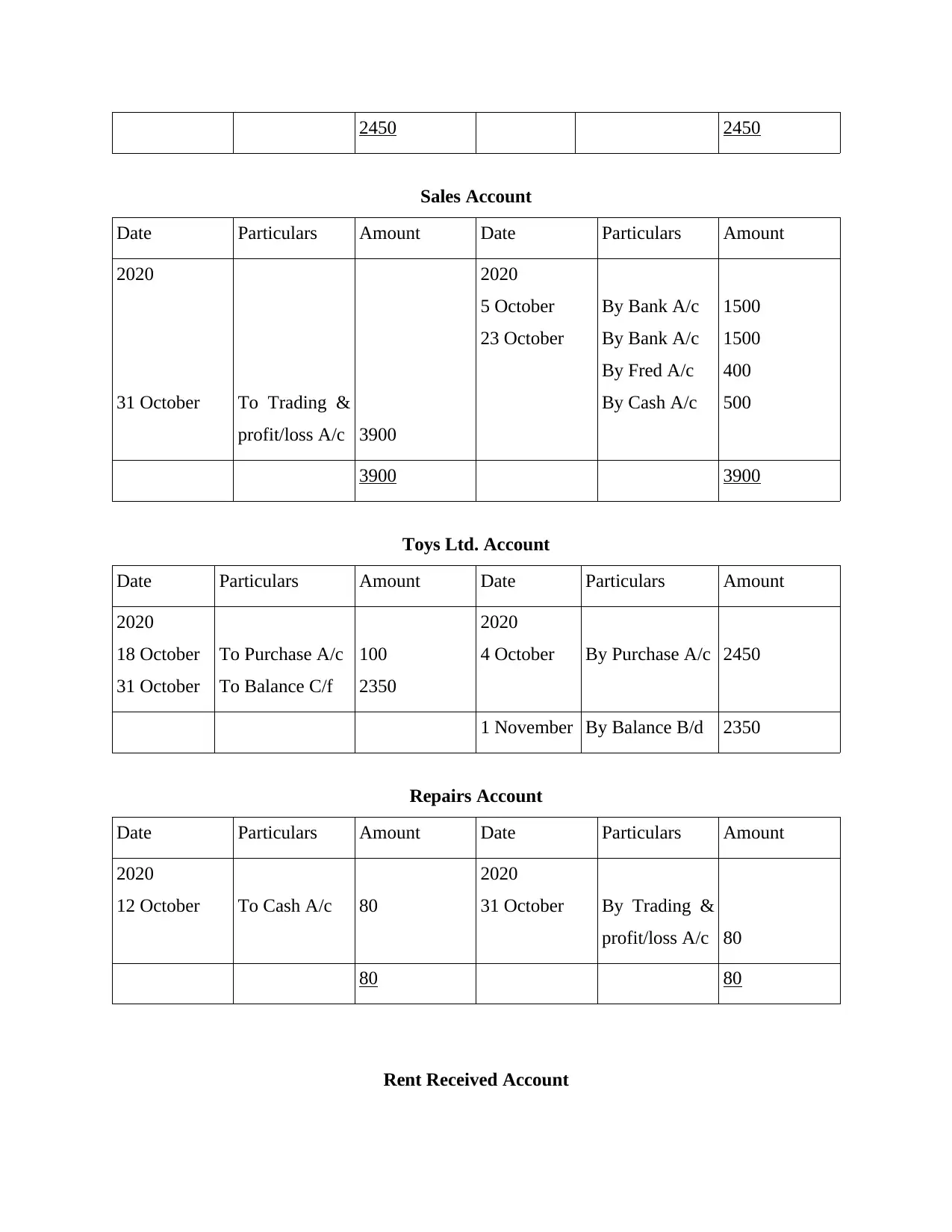
2450 2450
Sales Account
Date Particulars Amount Date Particulars Amount
2020
31 October To Trading &
profit/loss A/c 3900
2020
5 October
23 October
By Bank A/c
By Bank A/c
By Fred A/c
By Cash A/c
1500
1500
400
500
3900 3900
Toys Ltd. Account
Date Particulars Amount Date Particulars Amount
2020
18 October
31 October
To Purchase A/c
To Balance C/f
100
2350
2020
4 October By Purchase A/c 2450
1 November By Balance B/d 2350
Repairs Account
Date Particulars Amount Date Particulars Amount
2020
12 October To Cash A/c 80
2020
31 October By Trading &
profit/loss A/c 80
80 80
Rent Received Account
Sales Account
Date Particulars Amount Date Particulars Amount
2020
31 October To Trading &
profit/loss A/c 3900
2020
5 October
23 October
By Bank A/c
By Bank A/c
By Fred A/c
By Cash A/c
1500
1500
400
500
3900 3900
Toys Ltd. Account
Date Particulars Amount Date Particulars Amount
2020
18 October
31 October
To Purchase A/c
To Balance C/f
100
2350
2020
4 October By Purchase A/c 2450
1 November By Balance B/d 2350
Repairs Account
Date Particulars Amount Date Particulars Amount
2020
12 October To Cash A/c 80
2020
31 October By Trading &
profit/loss A/c 80
80 80
Rent Received Account
Paraphrase This Document
Need a fresh take? Get an instant paraphrase of this document with our AI Paraphraser
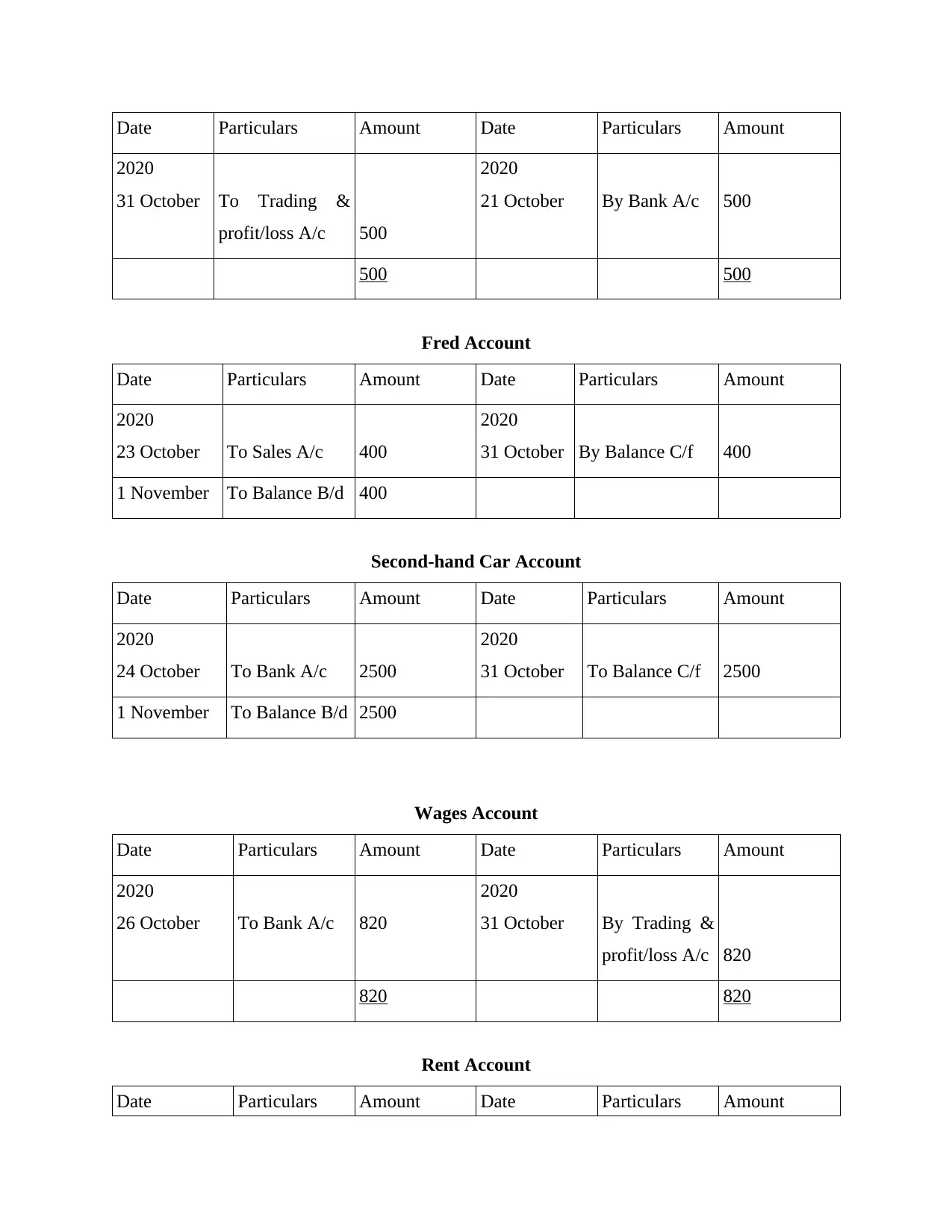
Date Particulars Amount Date Particulars Amount
2020
31 October To Trading &
profit/loss A/c 500
2020
21 October By Bank A/c 500
500 500
Fred Account
Date Particulars Amount Date Particulars Amount
2020
23 October To Sales A/c 400
2020
31 October By Balance C/f 400
1 November To Balance B/d 400
Second-hand Car Account
Date Particulars Amount Date Particulars Amount
2020
24 October To Bank A/c 2500
2020
31 October To Balance C/f 2500
1 November To Balance B/d 2500
Wages Account
Date Particulars Amount Date Particulars Amount
2020
26 October To Bank A/c 820
2020
31 October By Trading &
profit/loss A/c 820
820 820
Rent Account
Date Particulars Amount Date Particulars Amount
2020
31 October To Trading &
profit/loss A/c 500
2020
21 October By Bank A/c 500
500 500
Fred Account
Date Particulars Amount Date Particulars Amount
2020
23 October To Sales A/c 400
2020
31 October By Balance C/f 400
1 November To Balance B/d 400
Second-hand Car Account
Date Particulars Amount Date Particulars Amount
2020
24 October To Bank A/c 2500
2020
31 October To Balance C/f 2500
1 November To Balance B/d 2500
Wages Account
Date Particulars Amount Date Particulars Amount
2020
26 October To Bank A/c 820
2020
31 October By Trading &
profit/loss A/c 820
820 820
Rent Account
Date Particulars Amount Date Particulars Amount
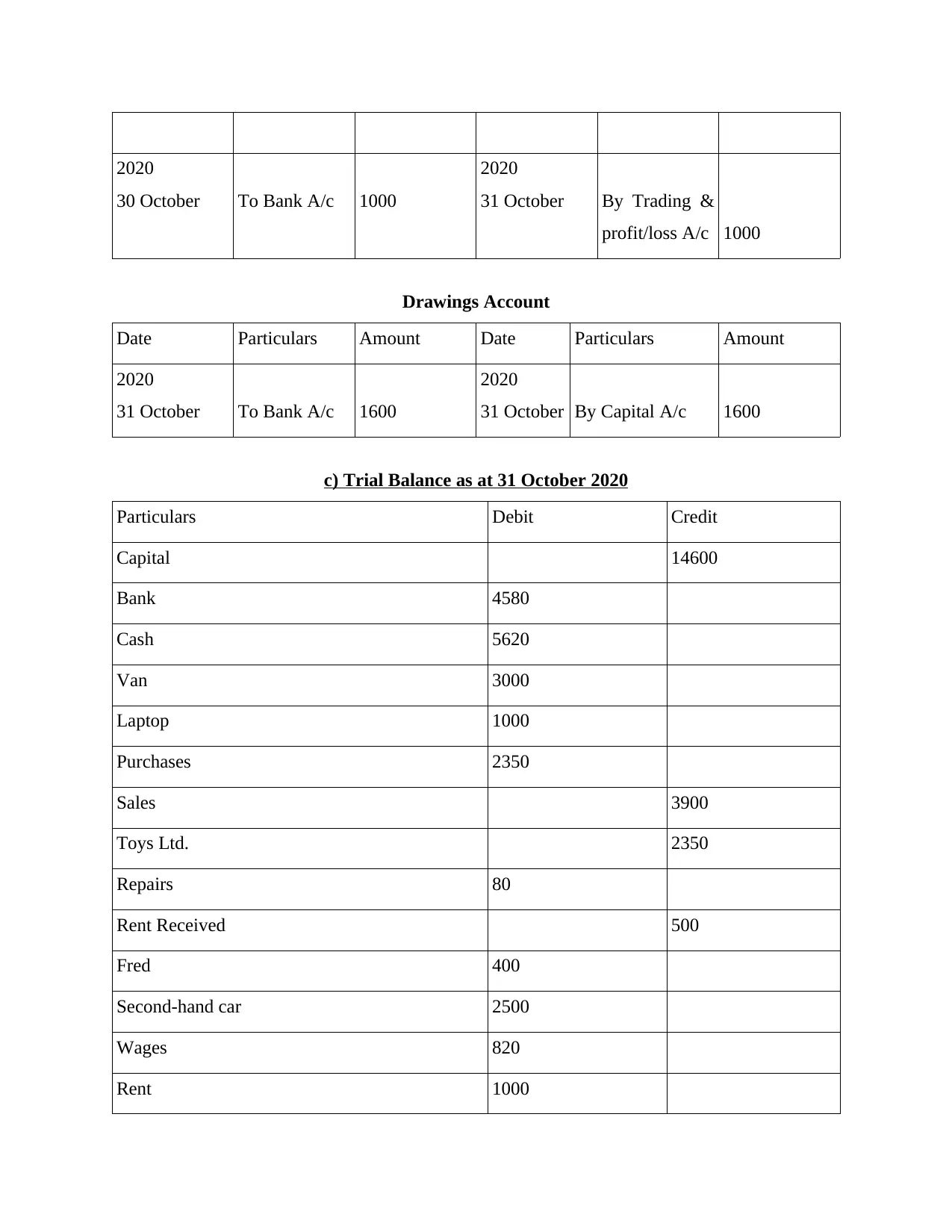
2020
30 October To Bank A/c 1000
2020
31 October By Trading &
profit/loss A/c 1000
Drawings Account
Date Particulars Amount Date Particulars Amount
2020
31 October To Bank A/c 1600
2020
31 October By Capital A/c 1600
c) Trial Balance as at 31 October 2020
Particulars Debit Credit
Capital 14600
Bank 4580
Cash 5620
Van 3000
Laptop 1000
Purchases 2350
Sales 3900
Toys Ltd. 2350
Repairs 80
Rent Received 500
Fred 400
Second-hand car 2500
Wages 820
Rent 1000
30 October To Bank A/c 1000
2020
31 October By Trading &
profit/loss A/c 1000
Drawings Account
Date Particulars Amount Date Particulars Amount
2020
31 October To Bank A/c 1600
2020
31 October By Capital A/c 1600
c) Trial Balance as at 31 October 2020
Particulars Debit Credit
Capital 14600
Bank 4580
Cash 5620
Van 3000
Laptop 1000
Purchases 2350
Sales 3900
Toys Ltd. 2350
Repairs 80
Rent Received 500
Fred 400
Second-hand car 2500
Wages 820
Rent 1000
⊘ This is a preview!⊘
Do you want full access?
Subscribe today to unlock all pages.

Trusted by 1+ million students worldwide
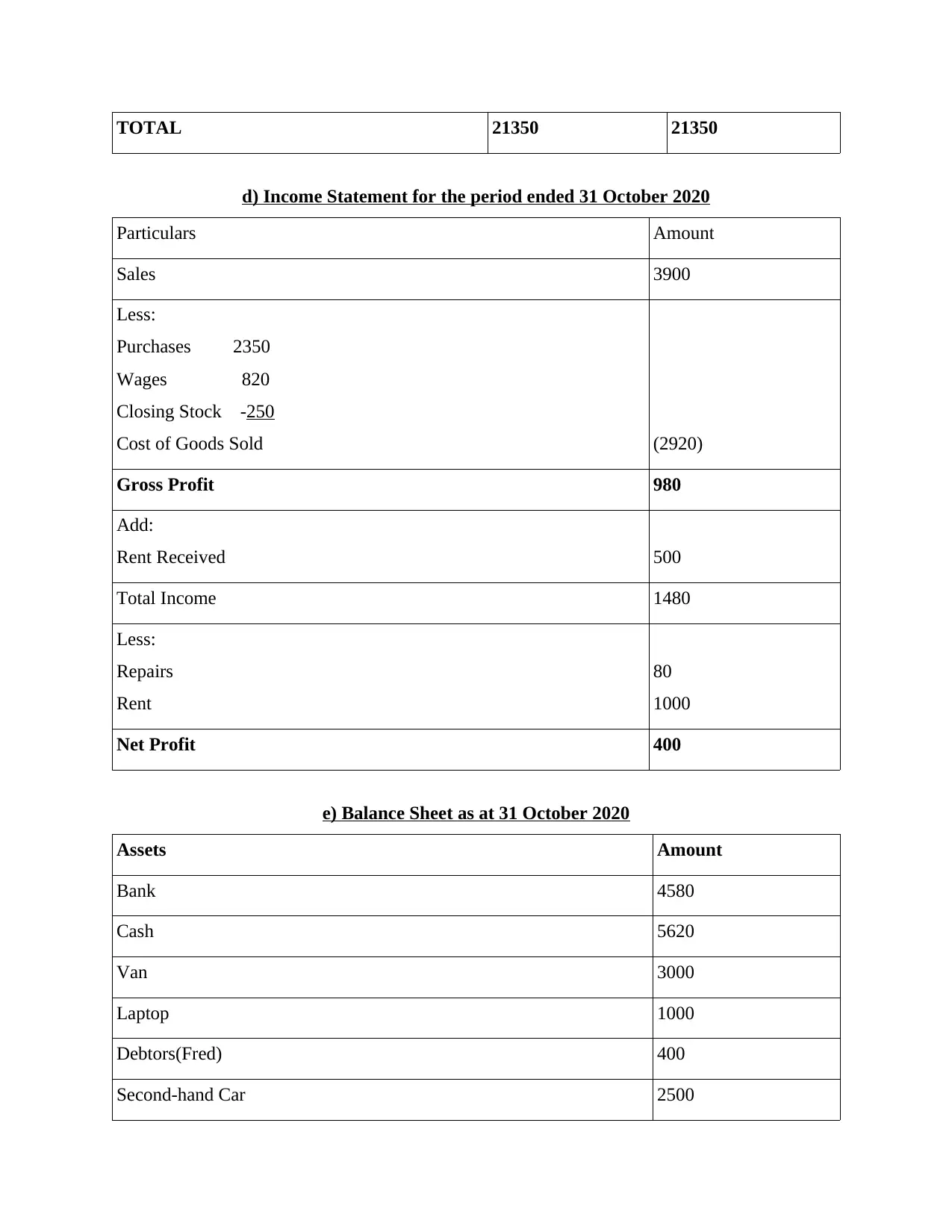
TOTAL 21350 21350
d) Income Statement for the period ended 31 October 2020
Particulars Amount
Sales 3900
Less:
Purchases 2350
Wages 820
Closing Stock -250
Cost of Goods Sold (2920)
Gross Profit 980
Add:
Rent Received 500
Total Income 1480
Less:
Repairs
Rent
80
1000
Net Profit 400
e) Balance Sheet as at 31 October 2020
Assets Amount
Bank 4580
Cash 5620
Van 3000
Laptop 1000
Debtors(Fred) 400
Second-hand Car 2500
d) Income Statement for the period ended 31 October 2020
Particulars Amount
Sales 3900
Less:
Purchases 2350
Wages 820
Closing Stock -250
Cost of Goods Sold (2920)
Gross Profit 980
Add:
Rent Received 500
Total Income 1480
Less:
Repairs
Rent
80
1000
Net Profit 400
e) Balance Sheet as at 31 October 2020
Assets Amount
Bank 4580
Cash 5620
Van 3000
Laptop 1000
Debtors(Fred) 400
Second-hand Car 2500
Paraphrase This Document
Need a fresh take? Get an instant paraphrase of this document with our AI Paraphraser
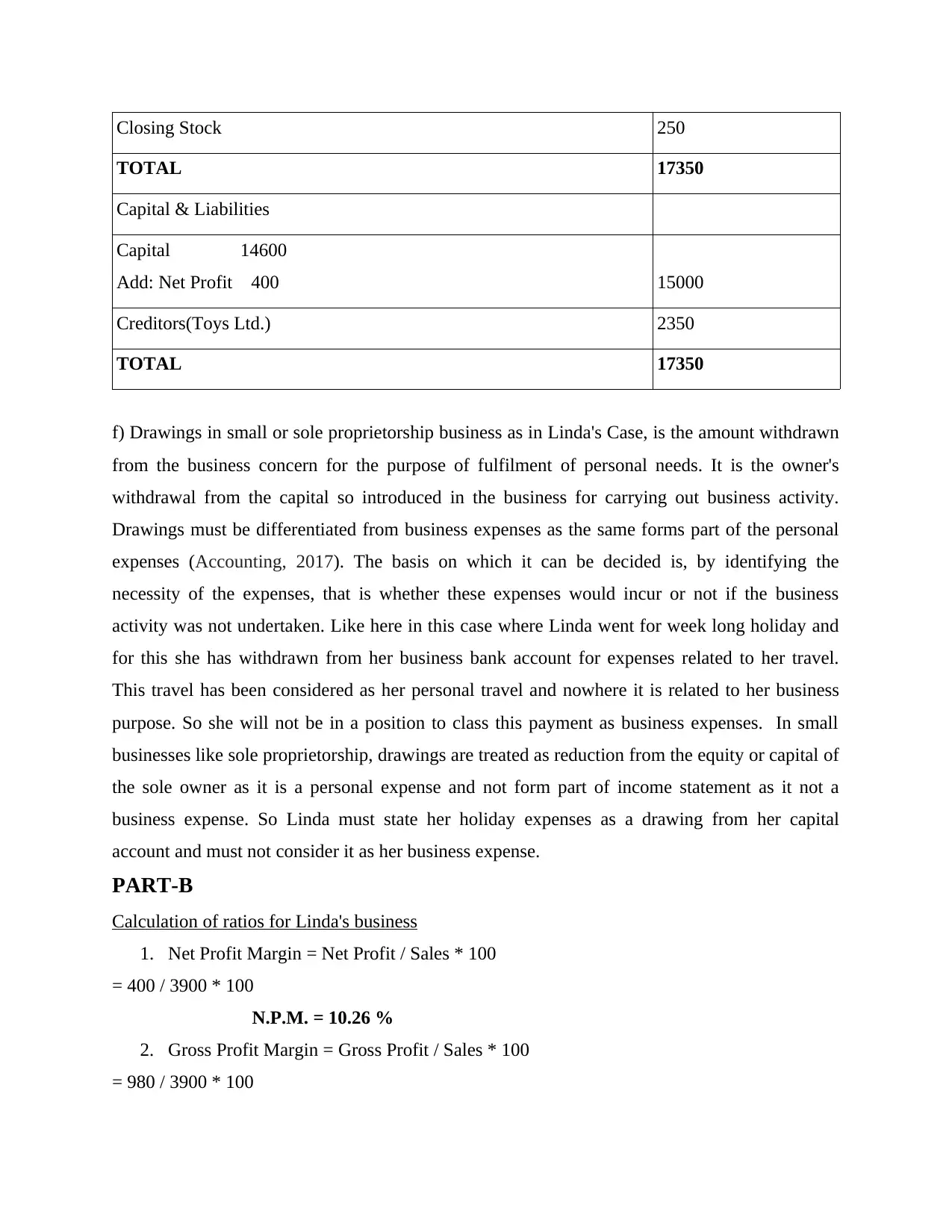
Closing Stock 250
TOTAL 17350
Capital & Liabilities
Capital 14600
Add: Net Profit 400 15000
Creditors(Toys Ltd.) 2350
TOTAL 17350
f) Drawings in small or sole proprietorship business as in Linda's Case, is the amount withdrawn
from the business concern for the purpose of fulfilment of personal needs. It is the owner's
withdrawal from the capital so introduced in the business for carrying out business activity.
Drawings must be differentiated from business expenses as the same forms part of the personal
expenses (Accounting, 2017). The basis on which it can be decided is, by identifying the
necessity of the expenses, that is whether these expenses would incur or not if the business
activity was not undertaken. Like here in this case where Linda went for week long holiday and
for this she has withdrawn from her business bank account for expenses related to her travel.
This travel has been considered as her personal travel and nowhere it is related to her business
purpose. So she will not be in a position to class this payment as business expenses. In small
businesses like sole proprietorship, drawings are treated as reduction from the equity or capital of
the sole owner as it is a personal expense and not form part of income statement as it not a
business expense. So Linda must state her holiday expenses as a drawing from her capital
account and must not consider it as her business expense.
PART-B
Calculation of ratios for Linda's business
1. Net Profit Margin = Net Profit / Sales * 100
= 400 / 3900 * 100
N.P.M. = 10.26 %
2. Gross Profit Margin = Gross Profit / Sales * 100
= 980 / 3900 * 100
TOTAL 17350
Capital & Liabilities
Capital 14600
Add: Net Profit 400 15000
Creditors(Toys Ltd.) 2350
TOTAL 17350
f) Drawings in small or sole proprietorship business as in Linda's Case, is the amount withdrawn
from the business concern for the purpose of fulfilment of personal needs. It is the owner's
withdrawal from the capital so introduced in the business for carrying out business activity.
Drawings must be differentiated from business expenses as the same forms part of the personal
expenses (Accounting, 2017). The basis on which it can be decided is, by identifying the
necessity of the expenses, that is whether these expenses would incur or not if the business
activity was not undertaken. Like here in this case where Linda went for week long holiday and
for this she has withdrawn from her business bank account for expenses related to her travel.
This travel has been considered as her personal travel and nowhere it is related to her business
purpose. So she will not be in a position to class this payment as business expenses. In small
businesses like sole proprietorship, drawings are treated as reduction from the equity or capital of
the sole owner as it is a personal expense and not form part of income statement as it not a
business expense. So Linda must state her holiday expenses as a drawing from her capital
account and must not consider it as her business expense.
PART-B
Calculation of ratios for Linda's business
1. Net Profit Margin = Net Profit / Sales * 100
= 400 / 3900 * 100
N.P.M. = 10.26 %
2. Gross Profit Margin = Gross Profit / Sales * 100
= 980 / 3900 * 100
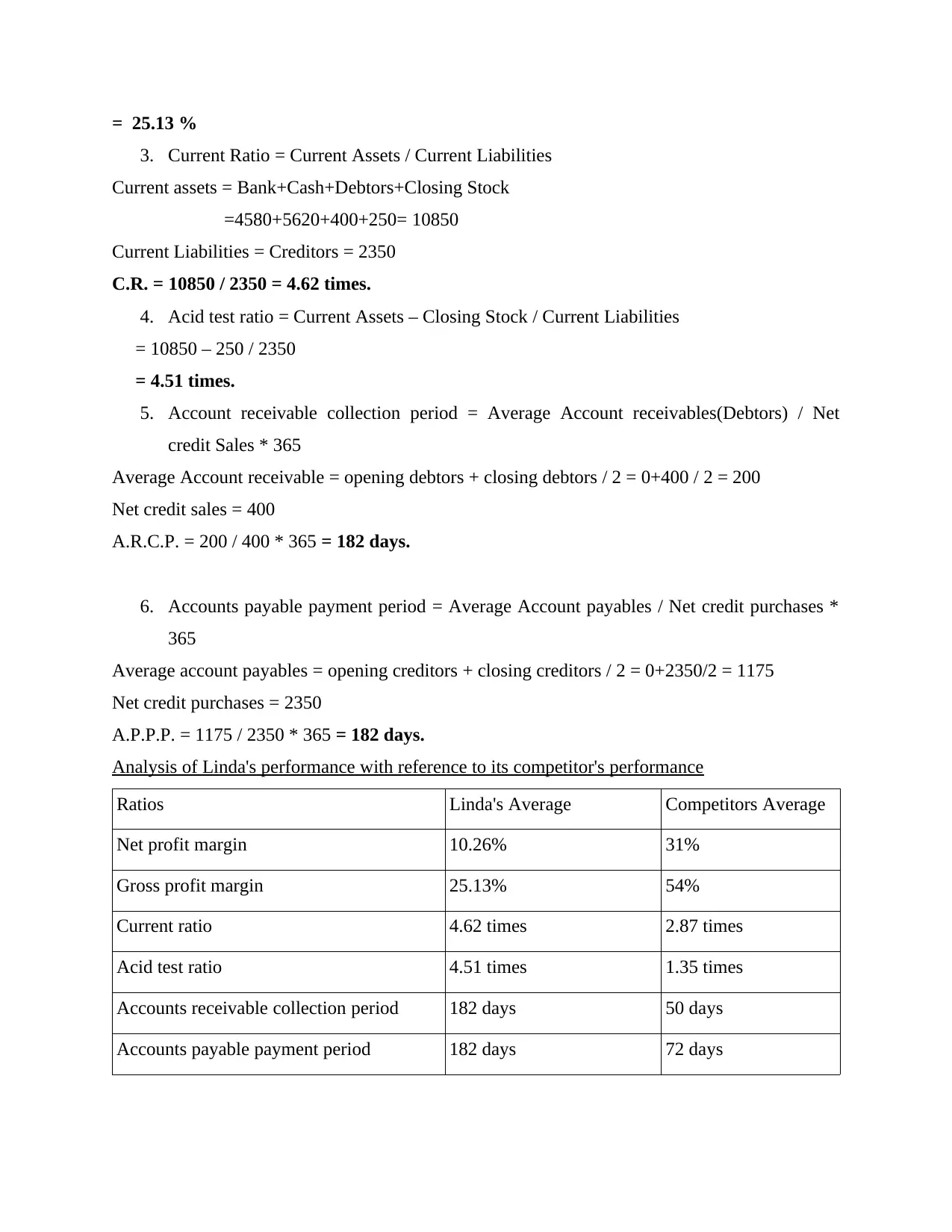
= 25.13 %
3. Current Ratio = Current Assets / Current Liabilities
Current assets = Bank+Cash+Debtors+Closing Stock
=4580+5620+400+250= 10850
Current Liabilities = Creditors = 2350
C.R. = 10850 / 2350 = 4.62 times.
4. Acid test ratio = Current Assets – Closing Stock / Current Liabilities
= 10850 – 250 / 2350
= 4.51 times.
5. Account receivable collection period = Average Account receivables(Debtors) / Net
credit Sales * 365
Average Account receivable = opening debtors + closing debtors / 2 = 0+400 / 2 = 200
Net credit sales = 400
A.R.C.P. = 200 / 400 * 365 = 182 days.
6. Accounts payable payment period = Average Account payables / Net credit purchases *
365
Average account payables = opening creditors + closing creditors / 2 = 0+2350/2 = 1175
Net credit purchases = 2350
A.P.P.P. = 1175 / 2350 * 365 = 182 days.
Analysis of Linda's performance with reference to its competitor's performance
Ratios Linda's Average Competitors Average
Net profit margin 10.26% 31%
Gross profit margin 25.13% 54%
Current ratio 4.62 times 2.87 times
Acid test ratio 4.51 times 1.35 times
Accounts receivable collection period 182 days 50 days
Accounts payable payment period 182 days 72 days
3. Current Ratio = Current Assets / Current Liabilities
Current assets = Bank+Cash+Debtors+Closing Stock
=4580+5620+400+250= 10850
Current Liabilities = Creditors = 2350
C.R. = 10850 / 2350 = 4.62 times.
4. Acid test ratio = Current Assets – Closing Stock / Current Liabilities
= 10850 – 250 / 2350
= 4.51 times.
5. Account receivable collection period = Average Account receivables(Debtors) / Net
credit Sales * 365
Average Account receivable = opening debtors + closing debtors / 2 = 0+400 / 2 = 200
Net credit sales = 400
A.R.C.P. = 200 / 400 * 365 = 182 days.
6. Accounts payable payment period = Average Account payables / Net credit purchases *
365
Average account payables = opening creditors + closing creditors / 2 = 0+2350/2 = 1175
Net credit purchases = 2350
A.P.P.P. = 1175 / 2350 * 365 = 182 days.
Analysis of Linda's performance with reference to its competitor's performance
Ratios Linda's Average Competitors Average
Net profit margin 10.26% 31%
Gross profit margin 25.13% 54%
Current ratio 4.62 times 2.87 times
Acid test ratio 4.51 times 1.35 times
Accounts receivable collection period 182 days 50 days
Accounts payable payment period 182 days 72 days
⊘ This is a preview!⊘
Do you want full access?
Subscribe today to unlock all pages.

Trusted by 1+ million students worldwide
1 out of 15
Related Documents
Your All-in-One AI-Powered Toolkit for Academic Success.
+13062052269
info@desklib.com
Available 24*7 on WhatsApp / Email
![[object Object]](/_next/static/media/star-bottom.7253800d.svg)
Unlock your academic potential
Copyright © 2020–2025 A2Z Services. All Rights Reserved. Developed and managed by ZUCOL.





